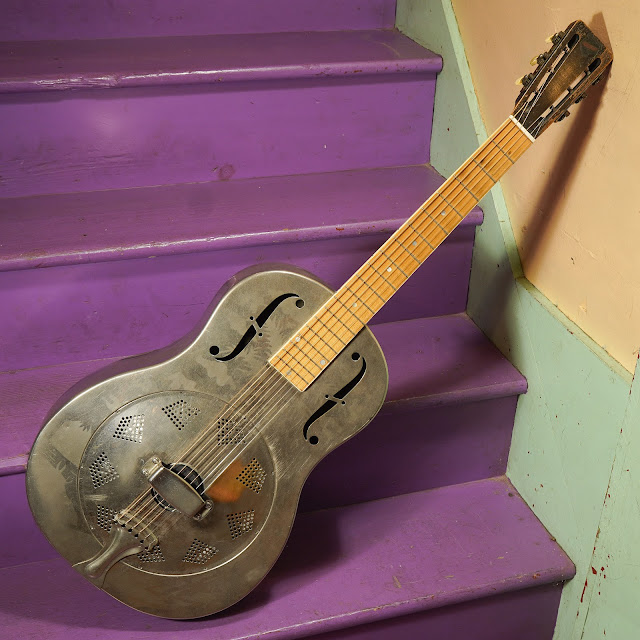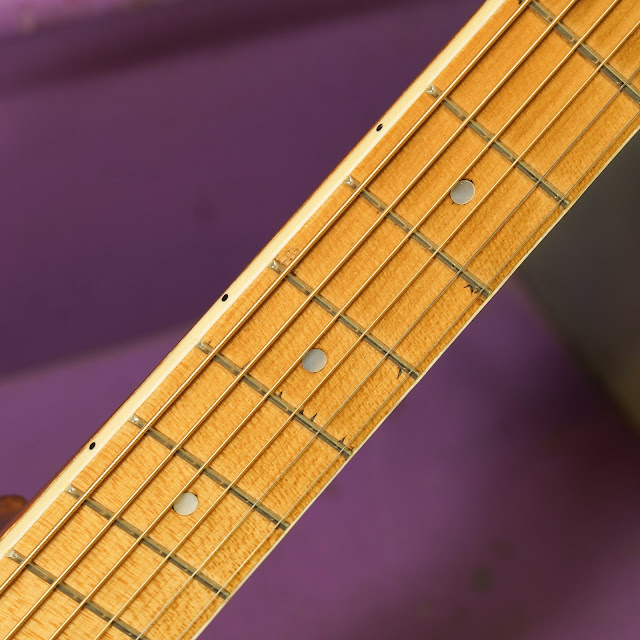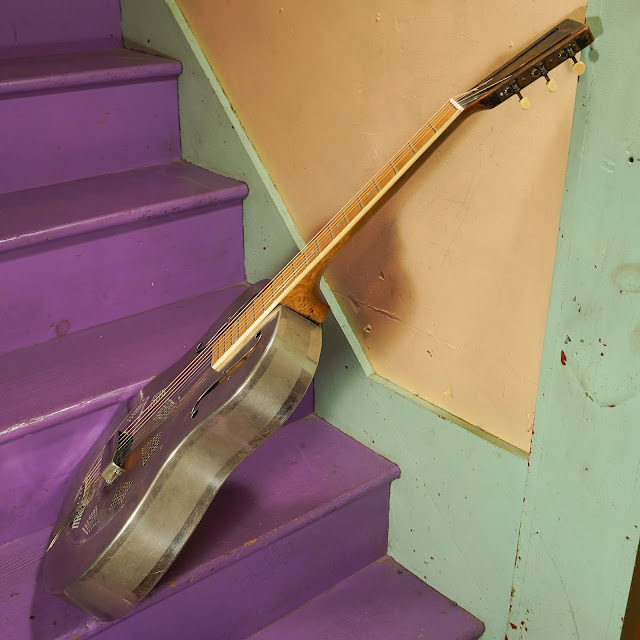1931 National Style O Resonator Guitar (Update)
I originally worked on this guitar back in 2015 but it's just come back-in for resale so I've decided to do my writeup on it all over again with updates.
To cut to the chase: this is an earlier National Style O from 1931 and it has the "hook-style" coverplate that only lasted that year. It's actually quite nice to use but I understand a lot of these lost their hooks with handling over time. This one still has all of those bits -- yip!
It features cool, tropical-motif etching all over the top and back of the body and with simple "banding" on the sides. The body hardware is all original except for the wrist-rest/bridge-cover (from a '40s coverplate). I used machine bolts to put-on the new cover because this one was originally riveted-on to the '40s coverplate it came off of and there was some mild damage to the coverplate on this '31 guitar anyhow. It makes setup adjustments a lot easier with it bolted-on, though!
The cone is a late-'30s National cone which was taken out of a '40s Kay-style resonator (of the sort that used National cones). The biscuit is a replacement, modern National one.
Its neck is original and even the fretboard is as well, though when I planed the (ebonized maple) fretboard before refretting in 2015, it sanded-out the stain and so is now a "natural maple" color. I can "black that out" like it was when new but I think it's far more fun with this happenstancing of the board. It originally didn't have side dots in the ivoroid fretboard binding, either, but I added those. The nut is bone and a replacement. The tuners are older but not original. They turn "upside-down" but still serve. I have a baggie of spare parts for them included with the guitar.
The previous repairs included all the usual work to get one of these humming -- a neck reset, board plane and refret, saddle compensation and adjustments, and setup-side stuff. I opened this guy up and checked all of its internals again, adding an additional reinforcement block ("mushroom") wedged between the dowel and the back of the guitar up near the neck joint. This helps stabilize the neck joint much better than if left "stock."
I then did a little cleaning, tightened anything needing tightening, and adjusted the saddle and setup. It's playing bang-on and is currently setup for a fingerpicking-friendly action height (quick and easy). I can set it up with either a taller saddle or shims to jack the action up if the next owner plans on using it mostly for slide, however.
Repairs included: (previously) a neck reset, board plane, refret, replacement cone, replacement bridge, replacement tuners, replacement nut, replacement bridge cover/wrist rest. This time around it got a fresh setup, cleaning, and adjustments.
Weight: 7 lbs 4 oz
Scale length: 25 1/8"
Nut width: 1 13/16"
Neck shape: medium C
Board radius: flat
Body width: 14
Body depth: 3 1/4"
Body: brass
Cone type: biscuit (single)
Bridge: maple
Fretboard: maple
Neck wood: maple
Action height at 12th fret: 3/32” bass 1/16” treble (fast, spot-on)
String gauges: 54w-12 lights
Truss rod: non-adjustable steel
Neck relief: straight
Fret style: medium-bigger
Condition notes: please read my description above thoroughly for references to originality/replacement parts. That aside, it's "worn-in" to beauty as far as my eye is concerned. There are no major dings, bumps, scrapes, or ugliness throughout the body. Its edges are all clean and undamaged. The finish, however, has lots of fine scratching/usewear all over and a good patch of picked-through plating on the coverplate where you'd expect it. Still, overall, it's dang handsome. The finish on back of the neck, by the way, is almost entirely "played-off" and rubbed-down to a super-comfy feel.
The only areas of concern for a "collector" rather than a "player" other than the parts changes would be the sanded/natural-finished fretboard color (I like it this way) and also a little "air gap" around the heel area. The neck is completely stable in its pocket but due to some wonkiness in this area when the guitar came in (the sides were never "straight" in this area, for instance, but slightly belled), post-reset there's a small gap in the joint (on the top side as the neck has been leaned back in the reset) and the fretboard extension dives down a bit as it runs over the body. It's been perfectly stable in service, however, and will continue to be. I tidy-up these wonky joints so they don't move around on the player because I know how frustrating that can be with metal-bodied resonator guitars on the road.
It comes with: a good hard case.




































Comments